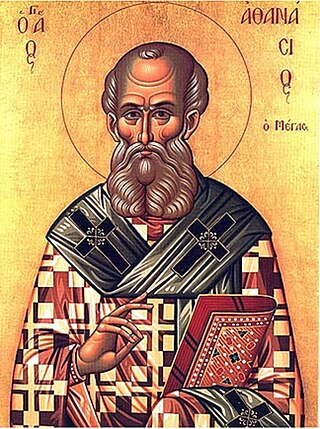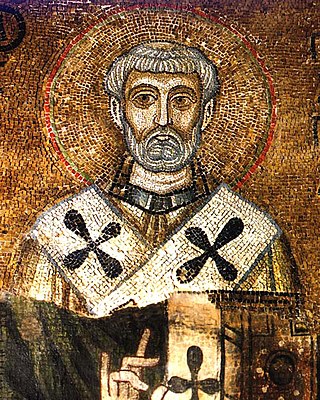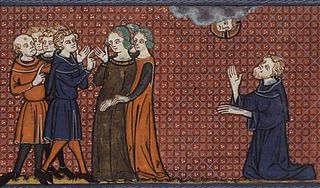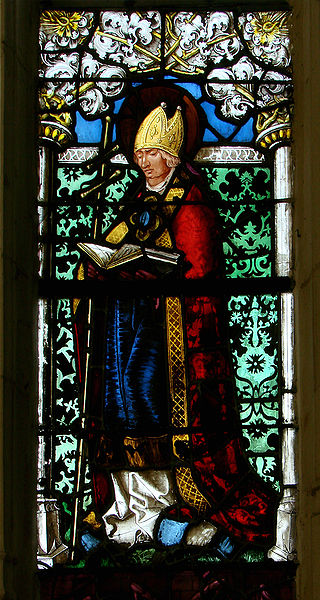Biography
According to Father Elie, [5] he was Bayeusain, and his hermitage was located at Blay, near Bayeux.
His great reputation for holiness brought him many visits from pilgrims who came to him for spiritual comfort.
However, the inhabitants managed to have him named bishop of Bayeux to succeed Saint Manvieu. [6] In this function he fought against the idolatry that still existed in this country, as well as against the nobles who traded it.
He has been attributed several miracles, one of which, on the way to Sees, he made water from the ground to Athis-de-l'Orne to quench his companions.
He died in 513. First buried in the church of Saint-Exupére, he was transferred in 1162 to the Benedictine abbey of Fécamp. His relics were then transported to Argentan where they escaped the Huguenots in 1562. The translation of his right femur in the church of Saint-Contest was done in 1896 during a great ceremony.
A municipality of the Caen conurbation is called Saint-Contest and the town of Mayenne is called Contest.

Athanasius I of Alexandria, also called Athanasius the Great, Athanasius the Confessor, or, among Coptic Christians, Athanasius the Apostolic, was a Christian theologian and the 20th patriarch of Alexandria. His intermittent episcopacy spanned 45 years, of which over 17 encompassed five exiles, when he was replaced on the order of four different Roman emperors. Athanasius was a Church Father, the chief proponent of Nicene theology against the anti-Nicenes, and a noted Egyptian Christian leader of the fourth century.

Benedict of Nursia, often known as Saint Benedict, was an Italian Christian monk, writer, and theologian. He is venerated in the Catholic Church, the Eastern Orthodox Church, the Oriental Orthodox Churches, the Lutheran Churches, the Anglican Communion, and Old Catholic Churches. In 1964 Pope Paul VI declared Benedict a patron saint of Europe.

Dunstan,, was an English bishop and Benedictine monk. He was successively Abbot of Glastonbury Abbey, Bishop of Worcester, Bishop of London and Archbishop of Canterbury, later canonised. His work restored monastic life in England and reformed the English Church. His 11th-century biographer Osbern, himself an artist and scribe, states that Dunstan was skilled in "making a picture and forming letters", as were other clergy of his age who reached senior rank.

Piran or Pyran, died c. 480, was a 5th-century Cornish abbot and saint, possibly of Irish origin. He is the patron saint of tin-miners, and is also generally regarded as the patron saint of Cornwall, although Michael and Petroc also have some claim to this title.

Harold Godwinson, also called Harold II, was the last crowned Anglo-Saxon English king. Harold reigned from 6 January 1066 until his death at the Battle of Hastings on 14 October 1066, the decisive battle of the Norman Conquest. Harold's death marked the end of Anglo-Saxon rule over England. He was succeeded by William the Conqueror.

Clement of Rome, also known as Pope Clement I, was a bishop of Rome in the late first century AD. He is considered to be the first of the Apostolic Fathers of the Church, and a leading member of the Church in Rome in the late 1st century.

Basil of Caesarea, also called Saint Basil the Great, was Bishop of Caesarea Mazaca in Cappadocia, Asia Minor. He was an influential theologian who supported the Nicene Creed and opposed the heresies of the early Christian church, fighting against both Arianism and the followers of Apollinaris of Laodicea.

Pelagia, distinguished as Pelagia of Antioch, Pelagia the Penitent, and Pelagia the Harlot, was a Christian saint and hermit in the 4th or 5th century. Her feast day was celebrated on 8 October, originally in common with Saints Pelagia the Virgin and Pelagia of Tarsus. Pelagia died as a result of extreme asceticism, which had emaciated her to the point she could no longer be recognized. According to Orthodox tradition, she was buried in her cell. Upon the discovery that the renowned monk had been a woman, the holy fathers tried to keep it a secret, but the gossip spread and her relics drew pilgrims from as far off as Jericho and the Jordan valley.

October 18 - Eastern Orthodox liturgical calendar - October 20

The Diocese of Bayeux and Lisieux is a Latin Church diocese of the Catholic Church in France. It is coextensive with the Department of Calvados and is a suffragan to the Archdiocese of Rouen, also in Normandy.

Willibald was an 8th-century bishop of Eichstätt in Bavaria.
Leontius of Caesarea was a bishop of Caesarea Mazaca, in Cappadocia. He was childhood friends with Gregory the Illuminator, later in life Leontius would consecrate Gregory to become the patriarch of the Armenians. Leontius attended the First Council of Nicaea in 325.

Nonnus was legendary 4th- or 5th-century Christian saint, said to have been an Egyptian monk who became a bishop in Syria and was responsible for the conversion of St Pelagia the harlot during one of the Synods of Antioch. His feast day is observed on November 10.

Saint Claudius of Besançon, sometimes called Claude the Thaumaturge, was a priest, monk, abbot, and bishop. A native of Franche-Comté, Claudius became a priest at Besançon and later a monk. Georges Goyau in the Catholic Encyclopedia wrote that “The Life of St. Claudius, Abbot of Condat, has been the subject of much controversy.” Anglican Henry Wace has written that "on this saint the inventors of legends have compiled a vast farrago of improbabilities."
Events from the 1080s in England.

Rictrude was abbess of Marchiennes Abbey, in Flanders. The main early source for her life is the Vita Rictrudis, commissioned by the abbey, and written in 907 by Hucbald.
Moses or Saint Moses spent many years in the 4th century as a hermit on the fringes of the Roman empire between Egypt and Syria, before becoming the first Arab bishop of the Arab people. As he was well respected for his piety, faith, and supposed performance of miracles, Mavia, an Arab warrior-queen, made his consecration as bishop over her people a condition of any truce with Rome.

Exuperantius of Cingoli was a 5th-century bishop of Cingoli,, in the Marche region of Italy. He is recognised as a saint in the Catholic and Eastern Orthodox Churches. Tradition attributes numerous miracles to his intercession both during his life and after his death, including the cessation of an outbreak of plague. Little is known about him with certainty, although he may have come from Africa.

December 4 - Eastern Orthodox liturgical calendar - December 6
Sigrada of Alsace was a Franco-Burgundian countess and mother of Ss. Warin, and Leodegar, and grandmother of St. Leudwinus.














